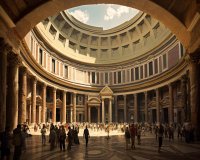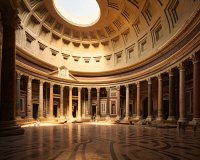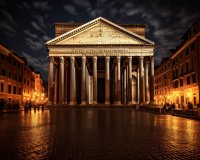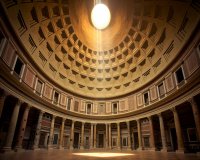Water and Stone: Trevi Fountain and the Pantheon in Art and History
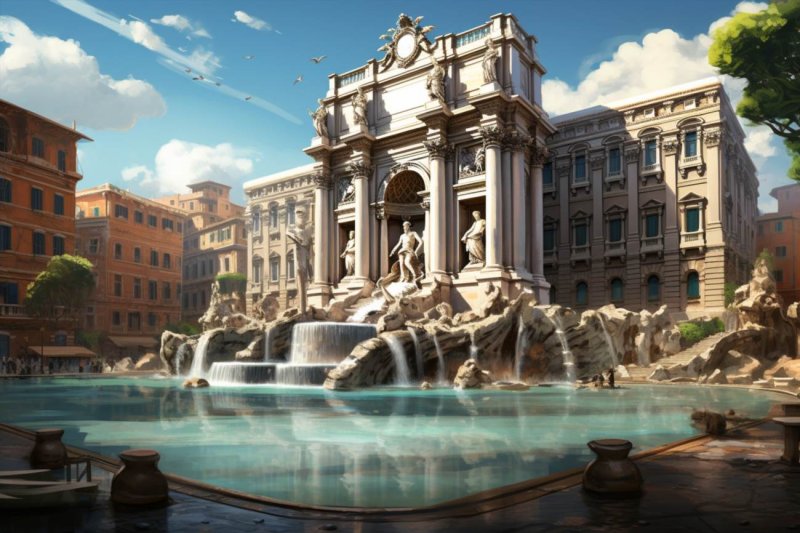
The Water and Stone: Trevi Fountain and the Pantheon in Art and History
Rome, often referred to as the "Eternal City," is a treasure trove of historical and artistic wonders. Two iconic landmarks that exemplify the city's rich heritage and artistic prowess are the Trevi Fountain and the Pantheon. These architectural marvels, standing as testaments to time, continue to captivate the hearts and minds of visitors from all corners of the globe.
The Trevi Fountain: A Symbol of Romance and Beauty
The Trevi Fountain, or Fontana di Trevi, is renowned for its grandeur and elegance. Designed by architect Nicola Salvi, this Baroque masterpiece was completed in the 18th century. The fountain stands as a tribute to the Roman tradition of celebrating water as a source of life and beauty.
The central figure of the Trevi Fountain is Neptune, the Roman god of the sea. He is flanked by Tritons, mythical sea creatures, and horses, symbolizing the ever-flowing abundance of water. Visitors flock to this site, not only to admire the intricately carved statues but also to partake in the age-old tradition of tossing a coin over their left shoulder into the fountain. This ritual is believed to ensure a return to Rome and is a testament to the enduring allure of the Trevi Fountain.
The Pantheon: A Marvel of Ancient Engineering
Contrasting with the grandeur of the Trevi Fountain is the Pantheon, an ancient Roman temple known for its remarkable architectural design. Built around 125 AD, it has withstood the test of time and remains remarkably intact. The Pantheon's iconic dome, with an oculus at its apex, continues to baffle architects and engineers with its precision and durability.
The Pantheon is dedicated to all gods, and its name itself means "temple of all gods." The oculus at the dome's center serves not only as a source of natural light but also as a connection to the divine. Rain occasionally falls through the oculus, a reminder of the unity between the heavens and the earth. Inside, visitors can marvel at the vast interior space, with its magnificent columns and the interplay of light and shadow.
Art and History: The Eternal Appeal
Both the Trevi Fountain and the Pantheon have been the inspiration for countless artists, writers, and filmmakers. They have featured prominently in various works of art and literature, further cementing their significance in the cultural tapestry of Rome and the world.
From Fellini's "La Dolce Vita" to Audrey Hepburn's iconic scene in "Roman Holiday," the Trevi Fountain has left an indelible mark on the silver screen. It has also been a muse for painters and photographers who seek to capture its enchanting beauty. Meanwhile, the Pantheon's timeless architecture has influenced countless buildings and structures across the globe, making it a symbol of architectural excellence.
Conclusion
The Trevi Fountain and the Pantheon are not mere tourist attractions; they are living embodiments of Rome's artistic and historical heritage. They remind us of the city's ability to seamlessly blend the old and the new, the spiritual and the secular. Whether you're tossing a coin into the Trevi Fountain or gazing up at the oculus of the Pantheon, these monuments evoke a sense of wonder and reverence that will continue to endure for generations to come.
Rome: Evening Exploration of City Highlights
Embark on an enchanting stroll through Rome as the sun sets and the city lights up in a mesmerizing display. Accompanied by a knowledgeable local guide, visit iconic landmarks such as Piazza Venezia and the awe-inspiring Pantheon.
Depending on your selected tour, rendezvous with your guide at either Trajan's Column or the lively Piazza Navona. As you amble through the historic neighborhoods, your guide will regale you with captivating stories of Rome's past and present, pointing out significant sites like the Trevi Fountain.
Discover the historical significance woven into various squares, delving into their role in Italy's unification and modern history. Pass by the quaintest of churches, unveiling its hidden painted illusion and intriguing tales of Rome's recent political figures. Continue the journey to witness more highlights of this ancient city.
Experience Rome's rich history and vibrant culture in the gentle glow of dusk or the enchanting nighttime lights. This guided walking tour promises a memorable exploration of Rome's historical center, showcasing its main monuments and offering unique insights into the heart of the city.
Includes:
- Expert Local Guide
- Guided Tour
Meeting Point
The meeting point may vary depending on the option booked for the tour. Please refer to the booking details for precise information.
Important Information
Before embarking on this enlightening journey through Rome, ensure you wear comfortable shoes and attire for a pleasant walking experience.
Don't miss out on this incredible opportunity to witness Rome's beauty at twilight or nightfall. Book your spot now and pay nothing today, allowing you to keep your travel plans flexible and stress-free.
The Cultural Significance of the Trevi Fountain in Rome
The Trevi Fountain in Rome, Italy, is one of the most iconic and revered landmarks in the world. This magnificent Baroque masterpiece is not just a tourist attraction; it holds profound cultural and historical significance. In this article, we will delve into the rich history and cultural importance of the Trevi Fountain.
A Masterpiece of Baroque Art
The Trevi Fountain is a true masterpiece of Baroque art, designed by the Italian architect Nicola Salvi and completed by Giuseppe Pannini in the 18th century. The fountain's intricate design and breathtaking sculptures make it a prime example of Baroque style, known for its ornate and dramatic features. The fountain's central figure, Neptune, dominates the scene, surrounded by sea nymphs and mythical creatures, all beautifully sculpted in Carrara marble.
Throwing a Coin for Good Luck
One of the most enduring and well-known traditions associated with the Trevi Fountain is the act of throwing a coin over your left shoulder into the fountain. Legend has it that if you toss one coin, you will ensure your return to Rome. Two coins can lead to a new romance, and three coins are said to bring marriage or divorce. This tradition is not only a fun and lighthearted tourist activity but also serves as a symbol of hope and goodwill.
Featured in Iconic Films
The Trevi Fountain has made its mark in popular culture, featuring prominently in several iconic films. Perhaps one of the most famous scenes involving the fountain is from the 1960 film "La Dolce Vita" directed by Federico Fellini. In this film, actress Anita Ekberg wades into the fountain, creating a lasting cinematic image that has become synonymous with the fountain itself.
The Fountain's Role in Roman History
Over the centuries, the Trevi Fountain has played a significant role in the history of Rome. It was built at the endpoint of the ancient Aqua Virgo aqueduct, a source of fresh water for the city. The fountain has been a crucial source of drinking water for Romans and was essential in the development and expansion of the city. Its enduring presence is a testament to its historical and cultural importance.
Restoration and Preservation
Preserving the Trevi Fountain's grandeur is a continual effort. The fountain has undergone multiple restorations to ensure its structural integrity and artistic beauty. In recent years, the Fendi fashion house generously sponsored a major restoration project, ensuring that this cultural gem remains a sight to behold for generations to come.
Conclusion
The Trevi Fountain is more than just a stunning work of art; it is a symbol of Rome's rich history and enduring culture. Its influence on art, cinema, and tradition cannot be overstated. As visitors from around the world continue to make their wishes and admire its beauty, the Trevi Fountain remains an enduring icon and a testament to the cultural significance of this remarkable city.
Rome: Trevi Fountain, Spanish Steps & Pantheon
Take an afternoon walking tour of Rome’s famous monuments and piazzas, dating back to Roman times, the Renaissance, and the Baroque era. Begin in Piazza del Popolo, known as the northern "door to Rome," with the Church of Santa Maria del Popolo as your first stop. Explore the lively atmosphere and stunning views of the Spanish Steps, winding alleys, and the ornate Trevi Fountain where you can make a wish. Visit Piazza Colonna, see the column of Marcus Aurelius, and stop by the iconic Pantheon. Admire Bernini's "Fountain of the Four Rivers" in Piazza Navona, and experience the vibrant energy of this lively city. This 2.5-hour tour provides a fantastic introduction to the Eternal City's art and architecture.
Highlights:
- Trace the history of Rome through its ancient monuments
- View the Roman temple of the Pantheon from outside in Piazza della Rotonda
- Admire Bernini's Fountain of the Four Rivers in Piazza Navona
- Experience the vibrant energy of the city through its lively piazzas
Get enchanted by the Eternal City as you stroll through picturesque cobblestone alleyways and immerse yourself in the rich history of Rome's iconic landmarks.
Includes:
- Expert guide
- Small groups of no more than 25 people
Not suitable for:
- People with mobility impairments
- Wheelchair users
Meeting point: Meeting point may vary depending on the option booked.
What to bring:
- Comfortable shoes
- Comfortable clothes
Not allowed:
- Shorts
- Baby strollers
- Luggage or large bags
- Short skirts
- Sleeveless shirts
- Baby carriages
Know before you go: Tour involves a fair amount of walking.
The Pantheon: A Timeless Symbol of Ancient Rome
The Pantheon, an architectural marvel and an enduring symbol of Ancient Rome, stands as a testament to the ingenuity and engineering prowess of the Romans.
Built in the heart of Rome, the Pantheon is a structure of remarkable historical and architectural significance. Its name, derived from Greek roots, translates to "all the gods," indicating its original purpose as a temple dedicated to the entire Roman pantheon of gods.
The construction of the Pantheon began in 118 AD during the reign of Emperor Hadrian, but it was built upon the foundations of an earlier temple commissioned by Marcus Agrippa in 27 BC. The grandeur of the Pantheon lies not only in its size but also in its distinctive dome, which was a remarkable feat of engineering for its time.
The Dome: The Pantheon's dome, an architectural wonder of its era, remains the largest unreinforced concrete dome in the world. The structure's dome is a perfect hemisphere with a diameter and height of 43.3 meters (142 feet), showcasing the Romans' mastery of concrete construction.
Architectural Design: The design of the Pantheon's dome is a brilliant combination of aesthetics and engineering. The structure features a series of stepped rings, decreasing in weight as they ascend, and relieving stress on the lower sections of the dome.
Interior: Upon entering the Pantheon, visitors are greeted by a vast and awe-inspiring space. The interior is adorned with marble and features a circular opening at the top of the dome, known as the oculus, allowing natural light to illuminate the space and creating a breathtaking effect.
Historical Significance: Over the centuries, the Pantheon has witnessed a transformation in its purpose, evolving from a pagan temple to a Christian church dedicated to St. Mary and the Martyrs. This transition speaks to the evolution of religious and cultural practices over time.
Modern Influence: The architectural marvel of the Pantheon continues to influence architects and designers to this day. Its dome, in particular, has inspired numerous structures and buildings, showcasing its enduring legacy.
In conclusion, the Pantheon stands as a timeless symbol of Ancient Rome, representing the genius of Roman engineering and architectural innovation. Its magnificent dome and historical significance make it a must-visit monument for anyone interested in the grandeur of ancient civilizations.




